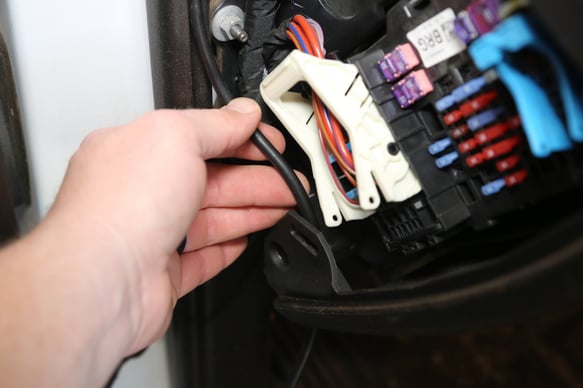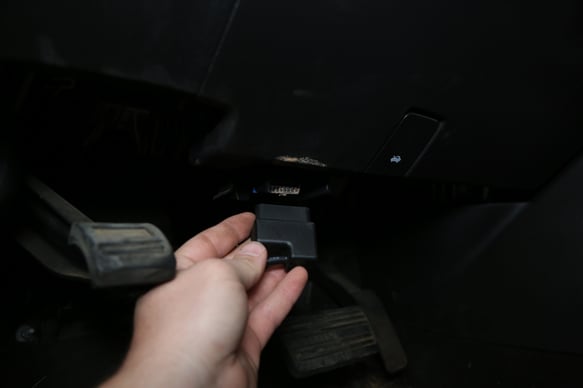Proper monitoring of your engine is critical for any vehicle, but even more so when you drive a diesel. Watching the EGT (exhaust gas temperatures), transmission temperatures, boost pressure, and regen cycles helps you keep an eye on your drivetrain so you can head off problems before they become serious issues. You could buy separate gauges and sending units, but that still doesn’t give you access to everything that you really need on a modern diesel truck. If you have a tuner module like the Edge Pulsar, you have to rely of secondary controls as well, further complicating the situation. The alternative to all that is an all-in-one unit that does all of that and so much more, like the Edge Insight CTS3 display unit.
 |  |
The Insight CTS3 comes with an OBD-II cable, zip ties, an alcohol swab, an interface cable to link up to a computer, and a suction cup mount. We opted to install a hard mount arm for our Chevrolet, which eliminates the possibility of damage should the suction cup come loose.
The Edge Insight CTS3 is not a tuner module. What the CTS3 display does is everything else. It has gauges to monitor your truck’s vitals, including EGTs and boost, vehicle parameter controls, data logging, code reading and clearing, tuner module control (on-the-fly), plus Edge's Expandable Accessory System (EAS), and performance testing. All of this in a simple easy to install display screen and that is easy to operate. What more could you want?
Let’s break this down section by section:
GAUGES
The stock gauge layout for the CTS3 is pretty impressive, but you could days deep diving all the gauge settings, fine tuning the CTS3 to get the looks and parameters you want. In the main gauge screen, you get RPM, EGT, Intake air temp, boost, MAF, Speed, coolant temp, gear, and fuel. You can add or remove gauges from the amin screen or create your own layout, there a lot of possibilities with the looks of the CTS3, you can even upload your own wallpaper background to the screen.
DATA LOGGING
If you need to run a data log for whatever reason, the CTS3 has the ability to record all of the OBDII data available from the ECM and display it through the EDGE DataViewer software on your computer. Whether you are trying to solve a problem or work out the kinks in a tune, the data logging capabilities of the CTS3 greatly simplify the process, as you don’t have to lug a laptop around. Simply open the data log screen and hit record. If you run into a problem and you want to see where it coming from while you are on the road, you can do it without hesitation.
|
|
|
|
|
|
The arm is attached to the driver's side grab handle mount, which is hidden beneath the plastic cover. Remove the cover with a pick tool, then remove the 10mm bolt. You won't be re-using this bolt, but you may want to keep it if you decide to remove the display later on. A plastic trim cover is installed into the open space, then the cover and arm are secured using a supplied Allen-head bolt. You might want to paint the arm to match your vehicle's interior before you install, but we were fine with the standard black for our truck.
CODE READING
Along with data logging, the CTS3 can show trouble codes and clear them on the fly. We actually used this feature recently with out 2018 Chevrolet 2500HD. The secondary battery has a shorted internal plate which caused some issues and threw some codes. We were able to continue driving, pull up the codes, clear them and kept going.
TUNER CONTROL
You can purchase the CTS3 by itself or as part of a kit with a Pulsar V3, which is what we have installed on our 2018 Chevrolet 2500HD. With the CTS3, the Pulsar is easier to access and change settings on the fly. You can enter all the parameters of the Pulsar V3 module from the CTS3 without using the steering wheel controls.
EXPANDABLE ACCESSORY SYSTEM (EAS)
We have not got into this yet on our truck, but there are a lot of possibilities with the expandable accessories. Edge has a plethora of options, including separate EGTs, turbo timer, universal 5v input, pressure sensors, back up cams, even a power module to control accessories such as lights, lockers, etc. through the CTS3 display.
|
|
PERFORMANCE TESTING
Want to know how your truck is doing before and after tuning changes or performance upgrades? The CTS3 has 0-60, 0-100, 1/8 and ¼-mile testing built right into the screen. It even has a Christmas tree starting light set up to test your reaction time. In addition to performance tests, the display also has pitch and roll gauges for off-roading or towing.
REGEN CYCLES
One of the more frustrating parts of modern diesels is the regeneration cycle. For most trucks, this is done automatically by the ECM about once per tank of fuel. The problem is that the truck has no idea that you were just heading to the gas station for a candy bar and a soda, so when it triggers the regen, it tells you to keep driving. If you don’t, the regen cycle is interrupted. A regen can last 40 minutes to an hour, so a short trip to the store isn’t going to cut it. If your truck can’t complete the regen cycle, it will eventually de-rate the ECM, and if this continues too long it will shut down the engine altogether.
The Duramax engine has the ability to do manual regen, which requires that the vehicle be parked with the hood up. This takes a while to complete and the truck will run hard during the process and the EGTs go over 572 degrees. You can also do a mobile regen, which we had to do on a recent trip with our truck.
The truck had tried to start a regen about 5 times, but we were on the road in Las Vegas and were not doing any highway driving. Eventually, the truck really didn’t like that it had not been able to do a complete regen by the time we were heading back home. We pulled up the regen page on the CTS3, set it mobile and then it didn’t do anything. We discovered that the mobile regen is not “on-the-fly”, you have to pull over, put the vehicle in park, start the mobile regen, then put the truck into gear and start driving. At this point, the regen began and we switched the gauges to the master panel that shows every parameter on screen and watched the EGTs as the process occurred and then we knew the moment the regen was finished. It was interesting watching how this works in real time.
|
|
|
|
The HDMI-style end of the OBD-II cable is plugged into the back of the display. On our Chevrolet, we routed the cable to the side of the driver's door, then pulled the weatherstripping back and pushed the cable inside of the gap. Then we popped the fuse panel cover off and routed the cable through so the other end of the cable is near the OBD-II port.
Using the CTS3 is easy, as it is a touchscreen display. Swipe up, down, left, and right to access different screens. The user interface is quite simple to understand. It even has wi-fi capabilities for software updates, which you need to do if you have a Pulsar V3 and want to control the tuner with it. It is a good idea to update the software before you complete the installation, but you can do this at your computer OR over wi-fi.
Installing the CTS3 is simple. You can mount the unit using the included suction cup mount, or purchase a separate vehicle-specific hard mount, which is what we did. To give the display access to the truck’s ECM, you have to dive in and do all kinds of crazy hard wiring…just kidding, you literally just plug it into the OBDII port. That is absolutely it, literally plug and play. You can mount the display wherever you want, so if you want to keep it out of prying eyes, do something custom.
Being fairly new to owning a modern diesel truck, we have learned a lot about the differences in running a diesel over gas, and the CTS3 has been instrumental in giving us the control over the truck we wanted with access to parameters we didn’t even know we needed to be monitoring.
|
|
The final step is simple: plug the OBD-II cable into the OBD-II port. That's it...now the display is operational. Once you start the truck, the screen will come alive with all of the options that the Insight CTS3 offers.
















